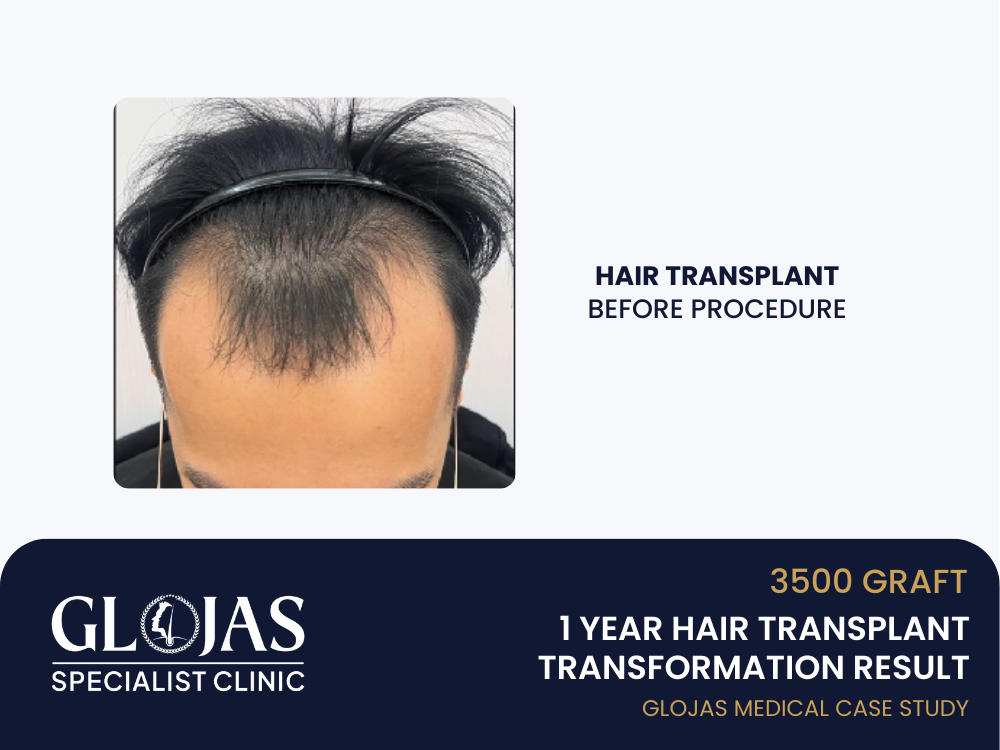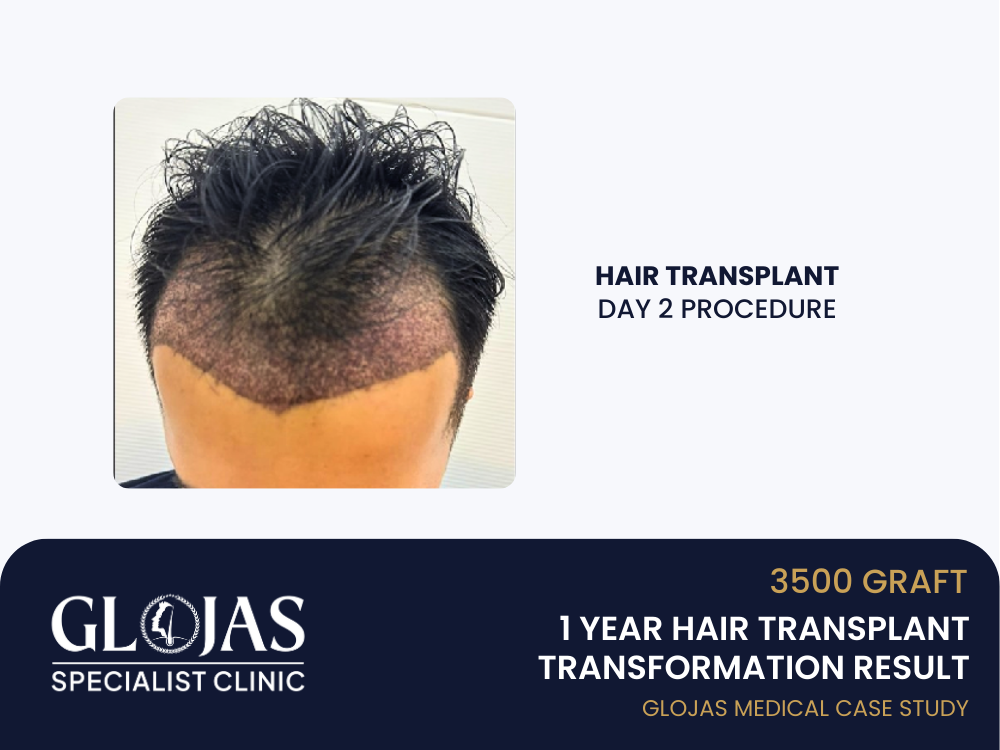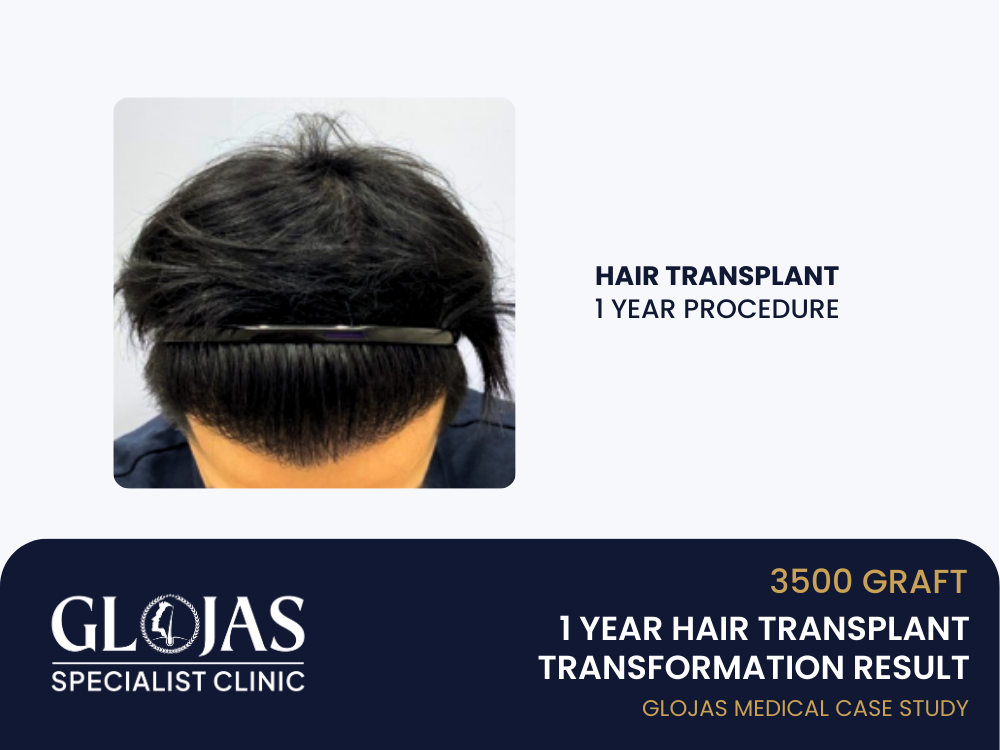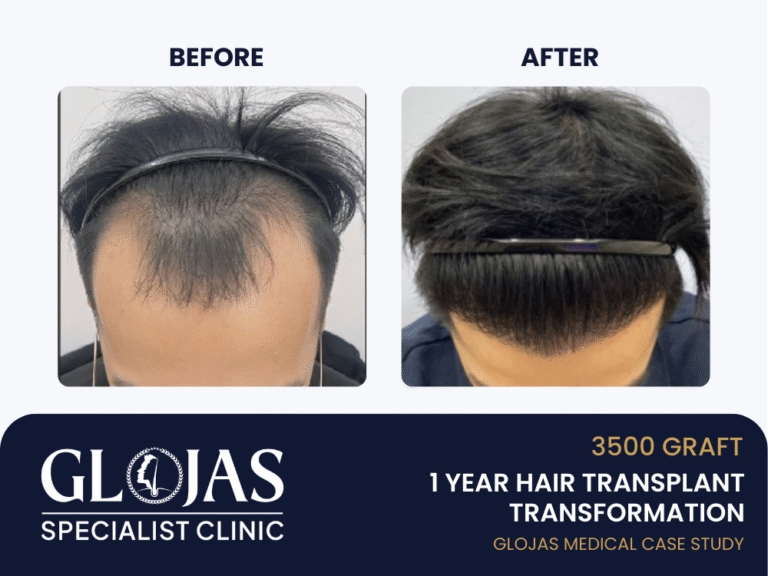Hair loss can slowly erode a person’s confidence, especially when it starts at the temples — one of the earliest and most visible signs of male pattern baldness.
This case study explores the journey of a 33-year-old male who underwent a SMART™ FUE Hair Transplant, using 3,500 grafts to correct a Norwood Class 3 hair loss pattern with noticeable temple thinning. After just one year, his hairline was restored to a youthful, natural state — and so was his self-esteem.
Patient Background
Name: Mr. A (name withheld for privacy)
Age: 33
Issue: Progressive hairline recession, especially at the temples
Hair Loss Classification: Norwood 3
Hair Type: Wavy, medium density
Previous Treatments: DHT-blocking shampoo, no medications
Mr. A had been experiencing gradual temple recession since his mid-20s. By the time he is 30, his frontal hairline has formed a visible “M” shape, making him appear older than he feels.
Why SMART™ FUE Hair Transplant?
SMART™ FUE (Scalp Micro-Advanced Restoration Technique) is an enhanced version of the traditional FUE (Follicular Unit Extraction) method. It provides:
Ultra-precise extraction and placement
Minimal scalp trauma
Higher graft survival rate (up to 95%)
Natural hairline reconstruction with accurate angling
No visible scarring
For delicate areas like the temples and frontal hairline, where hair grows in unique directions and angles, SMART™ FUE offers unmatched control and realism.
Consultation & Planning – Hair Transplant
Mr. A consulted with a hair restoration specialist to assess his scalp and discuss expectations.
Observations:
Hairline receded at both temples with mild thinning at the mid-frontal zone
The crown was stable with no visible loss
The donor area (back of scalp) had high graft density
Treatment Plan:
Total 3,500 grafts
2,200 for the temples and hairline
1,300 for mid-scalp density improvement
Design a conservative, natural hairline with subtle temple rounding
Ensure density of ~40 grafts/cm² for even blending with native hair
Procedure Summary

Duration: 8 hours (1-day session)
Team: Lead surgeon + 2 skilled technicians
Tools: 0.8 mm micro-punch, sapphire blade for recipient sites
Steps:
Hairline drawn and approved by the patient
Local anesthesia administered
3,500 grafts extracted using SMART™ FUE
Grafts sorted by type: singles for hairline, doubles/triples for volume
Recipient sites created to match angle, direction, and density
Grafts are implanted meticulously to recreate a youthful hairline
Mr. A experienced no pain and minimal post-op swelling.
Recovery Timeline

Day 1–3: Minor redness, slight forehead swelling
Week 1: Scabbing and tightness (normal); scalp cleaned gently
Week 3–4: Shedding phase (shock loss) begins
Months 3–4: Early regrowth seen at temples
Months 6–8: Significant thickening and hairline reshaping
Month 12: Full result visible
1-Year Results

After 12 months, Mr. A returned for a follow-up. His transformation was both natural and complete.
| Area | Before Transplant | After 12 Months |
|---|---|---|
| Temples | Receded, thinning, “M” shaped | Dense, youthful contour |
| Frontal Hairline | Uneven, lacked density | Smooth, symmetrical design |
| Mid-scalp | Slightly thin | Even density, no visible gaps |
| Confidence | Avoided short hairstyles | Regular trims, new haircut style |
His friends and family noted the improvement immediately, yet no one suspected a hair transplant — a true sign of success.
Patient Testimonial
“It looks so natural that people think I just started styling my hair differently. Best investment I’ve ever made.”
Maintenance Plan
Continued use of mild DHT-blocking shampoo
Bi-annual check-ups with the clinic
No medication or supplements required
Optional PRP maintenance (every 6 months) to support density
Frequently Asked Questions (FAQ)
1. Why did this patient need 3,500 grafts?
For Norwood 3 hair loss with temple recession and slight mid-scalp thinning, 3,000–3,500 grafts is ideal for natural density and full restoration.
2. Will the transplanted hair fall out again?
No. Hair from the donor zone (back of the scalp) is genetically resistant to DHT and is permanent after successful transplantation.
3. When do results become visible?
Initial growth starts around month 3–4, with full results typically seen by 9–12 months.
4. Is the SMART™ FUE method better than regular FUE?
Yes. SMART™ FUE improves graft survival, minimizes trauma, and allows more precise angling, especially in areas like the temples and frontal hairline.
5. Can I style my hair after the transplant?
✅ Absolutely. Once healed, transplanted hair can be washed, styled, trimmed, or dyed like natural hair.
Final Thoughts
This case study shows how 3,500 grafts using SMART™ FUE can restore a natural-looking, dense hairline — even in moderate Norwood 3 hair loss.
Mr. A’s one-year results speak for themselves: seamless temple coverage, balanced hairline, and renewed confidence.
If you’re noticing early recession at the temples or want to redefine your hairline before it progresses, SMART™ FUE offers a modern, minimally invasive, and long-term solution.

